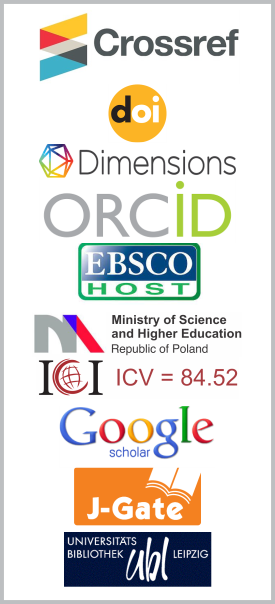Usability Study on Online Database of Undergraduate Students at Higher Institution
DOI:
https://doi.org/10.26713/jims.v9i4.987Keywords:
Usability, Online database, Learnability, EfficiencyAbstract
In current research environment and needs, the online database becomes one of the main resources in retrieving latest academic information and knowledge. This is due to reason that its synchronization (latest and frequently updated resources) with the on-going research trends and demands. The online database contains a collection of data, text, numerical, graphical, electronic journals, multimedia products and others. Usability of an online database for students may imply on accessing resources for meeting their assignment, project papers and research requirements. In education needs at the higher institution, students have long been using the database to fit in with their study. Nevertheless, little is known from the past works on the students' online database usability. A survey is conducted on undergraduate students at Universiti Tenaga Nasional (UNITEN), Malaysia. The aim is to examine the relationships between learnability and efficiency, and usage of the online database among these engineering students. The findings indicate that the UNITEN Library should have an opportunity to improvise their online database with respect to learnability and efficiency factors. The research is carried out through a survey participated with a total of 352 respondents. Findings indicate that, 71.7% used the online database and 28.3% was not. Furthermore, usage relationships were found to be with coefficient \(r=-0.353\) (Learnability) and \(r=-0.382\) (Efficiency). Both of the correlations are significant at 1% significant level. The researcher suggested carrying out a further study to investigate the relationship of learnability, efficiency and inclusive of other factors like the effectiveness of the online database to reflect the usability.
Downloads
References
S. D. Lee and F. Boyle, Building an electronic resource collection: a practical guide, 2nd ed., Facet Publishing, London (2004).
T. Manorama and V. K. J. Jeevan, A selective review of research on e-resource usage in academic libraries, Library Review 62(3) (2013), 134 – 156.
D. S. Perpetua, Electronic resources: access and usage at Ashesi University College, Campus-Wide Information Systems 22(5) (2005), 290 – 297.
A. E. Ibrahim, Use and user perception of electronic resources in the United Arab Emirates University (UAEU), International Journal of Libraries and Information Studies (Libri) 54(1) (2004), 18 – 29.
S. Majid and A. T. Tan, Usage of information resources by computer engineering students: a case study of Nanyang Technological University, Singapore, Online Information Review 26(5) (2002), 318 – 325.
J. C. Crawford and A. Daye, A survey of the use of electronic services at Glasgow Caledonian University Library, The Electronic Library 18(4) (2000), 255 – 265.
N. Faizul and P. M. Ali, Awareness and use of e-journals by IIT Delhi and Delhi University library users, Collection Building 32(2) (2013), 57 – 64.
N. H. Sinh and H. T. H. Nhung, Users' searching behaviour in using online databases at Vietnam National University-Ho Chi Minh City, Library Management 33(8/9) (2012), 458 – 468.
C. Tenopir, Factors that influence database use, in Proceedings of the Ninth National Conference of the Association of College and Research Libraries, Detroit, April 8–11, American Library Association, Chicago, 68 – 75 (1999).
M. R. A. Kadir, F. A. Saaid and D. Singh, PLS path model for testing the moderating effects in the relationships among formative IS usage variables of academic digital libraries, Australian Journal of Basic and Applied Sciences 6(7) (2012), 365 – 374.
N. T. Haider, Use of electronic databases by postgraduate students and research scholars at GBPUAT Library, India. Library Philosophy and Practice, p. 809 (2012).
B. Shackel, Usability – Context, framework,definition, design and evaluation, in Human Factors for Informatics Usability, B. Shackel and S. J. Richardson (eds.), 21 – 37, Cambridge University Press, New York (1991).
J. Nielsen, Usability Engineering, Academic Press, Cambridge, MA (1993).
International Standards Organization, Ergonomic requirements for office work with visual displayterminals, Part 11: Guidance on usability (ISO DIS 9241-11), International Standards Organization, London (1994).
I. Newman. Qualitative-quantitative Research Methodology: Exploring the Interactive Continuum, Southern Illinois University Press, Carbondale (1998).
A. Bryman, Barriers to integrating quantitative and qualitative research, Journal of Mixed Methods Research 1 (2007), 8 – 22.
M. Saunder, P. Lewis and A. Thornhill, Research Methods for Business Students, 5th ed., Prentice Hall, New York (2009).
Downloads
Published
How to Cite
Issue
Section
License
Authors who publish with this journal agree to the following terms:- Authors retain copyright and grant the journal right of first publication with the work simultaneously licensed under a CCAL that allows others to share the work with an acknowledgement of the work's authorship and initial publication in this journal.
- Authors are able to enter into separate, additional contractual arrangements for the non-exclusive distribution of the journal's published version of the work (e.g., post it to an institutional repository or publish it in a book), with an acknowledgement of its initial publication in this journal.
- Authors are permitted and encouraged to post their work online (e.g., in institutional repositories or on their website) prior to and during the submission process, as it can lead to productive exchanges, as well as earlier and greater citation of published work.




